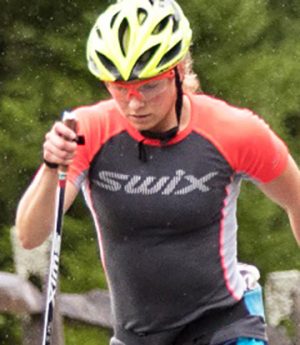April 13, 2015 – Athletic success is rarely linear. Press clippings and annual highlights love to portray a smooth curve of improvement and the inexorable march towards success, but there are very few careers that can be graphed on a smooth chart up and to the right. Illness, injury, age and circumstance conspire to make athletics unknowable and unpredictable-which is what makes it so interesting. The 2015 incarnation of the American cross-country ski racers saw improvement and success but not without hardship. Here are the five ways it broke down for American skiers in the 2014/2015 season.
THE EARLY SEASON: THE NORWAY MONTHS
Short of “competitions surrounding brown cheese” there are no other venues in which the United States – with its 320 million person population and 16 trillion dollar GDP – plays second fiddle to the Viking state frozen in northern Europe. That “dour land without sunshine or garlic,” as the writer Jim Harrison once described Norway, boasts a GDP approximately half of what the U.S. spends on its armed forces. Yet, to watch the dominance foisted on the World Cup this season, one might think the Viking raids into Europe that marked the first century C.E. had been resumed with overbuilt waxing trucks and red spandex armor. The cultural forces behind skiing in its origin country continued as they won every World Cup event prior to the holiday break and took 26 of 32 possible podium positions.
The early period wasn’t without success for U.S. skiers. Ida Sargent put together an impressive fifth-place finish in the Kuusamo sprint, Sophie Caldwell made her first semifinal rounds in Davos. “Our focus was to come into this season more conservatively and to build into the most important races,” head coach Chris Grover explained.
The U.S. wasn’t alone in head scratching at how to beat back the red army of sharply fit skiers vying for a spot at this year’s World Championships. “Others will draw closer,” Grover said in December. “We will draw closer.”
THE TOUR DE LIZ: THE U.S. LOOKS BETTER
Then it happened. The U.S. did draw closer and did so carried emotionally by the team’s (literally) smallest member: Liz Stephen. Solid efforts in period one from Sadie Bjornsen and Jessie Diggins gave insight into the health and fitness of the program, but it was a breakthrough performance from Liz Stephen that lifted the emotional tenor of the program. “I made it my goal to be in the top five,” Stephen described in the hours before the final stage of the seven-stage Tour de Ski-the signature hill climb up the Alpe Cermis.
That Stephen would do well on the Alpe Cermis was nearly a matter of course. She’d posted the second-fastest time the year previous and has long been the best pure climber in the U.S., having smashed events like the Whiteface uphill rollerski time trial held in October. What was different about Stephen’s performance in 2015 however was the way she skied when the terrain didn’t pitch upwards. More consistent results in both the sprint events and particularly the rolling distance events put Liz into contention. “She skied with much more power and poise,” described U.S. women’s coach, Matt Whitcomb. She looked more within herself.
When the snow settled after a hard fought battle with Norwegian Ragnild Haga, Stephen sat atop the Alpe Cermis and U.S. skiing history, her top five goal achieved. “Watching an athlete accomplish a top-tier goal like that is really satisfying and we are all proud of her ability to prepare and execute,” Whitcomb concluded.
Stephen’s confidence spiked and her performances spurred on more top-10 finishes from her teammates in following World Cups, as well as a podium finish for Stephen in the 10k event held in Rybinsk, Russia. Stephen credited the team with the emotional feeling that allowed the result to happen. “It means a lot to be with this team, having this result, and knowing that you’re never ever out there by yourself,” said Stephen. “Good days, bad days, great days, this team forms around you.”
Just as notably, Stephen’s teammates Jessie Diggins finished 12th while Rosie Brennan, fresh from commanding performances in the U.S. Cross Country Championships, finished 13th-an impressive World Cup distance effort.
THE WHOLE WAY: SUCCESS AT THE WORLD CHAMPIONSHIPS
“We’ve never had U.S. girls podium at a distance event at the World Champs and to have two? It’s incredible. We talked at the team meeting last night and I said, ‘Why not me?'” Jessie Diggins explained after her historic podium with teammate Caitlin Gregg at the World Championships.
If Diggins had posed the question out loud to fans, coaches and competitors, there may have been a dozen or so legitimate reasons given as to why she and Gregg wouldn’t have scored the results that she did-history, Norway, confidence, ability. But yet, a turn of events positioned Diggins and Gregg perfectly to capitalize and win. And with that, the U.S. skiing notched important and impressive results. “It’s our hope that these results inspire the kids back home,” said Caitlin Gregg on Swedish television from the sight of the championships.
There’s little doubt U.S. skiers watching sat back shortly thereafter and said, “Why not me?”
THE HICCUPS
If Gregg, Stephen, Diggins and their teammates were the steadily rising part of the year’s athletic curve, what were the setbacks, the plateaus? There was injury: Noah Hoffman broke his fibula in a dramatic crash in the opening World Cup of the season that caused him to miss the majority of the year. “You don’t see a crash like this often,” Hoffman told the Denver Post. “It’s not a place I want to be breaking new ground.”
Hoffman wasn’t the only U.S World Cup regular unexpectedly at home in January. Inexplicably, Kikkan Randall, couldn’t find her trademark speed and winning ways. The country’s most decorated cross country skier left the World Cup to recuperate for two weeks in January. It was the first real recovery Kikkan took since the Sochi games and it paid off, albeit later than expected. Throughout much of the season, including the World Championships, Randall lacked a bit of the turbo boost that made her a three-time overall sprint World Cup winner. It was less a triumph than a relief when Randall made the Lahti Freestyle sprint podium on March 11. “Making the podium today felt really good after such a frustrating season,” relayed Randall. “I’ve always believed I could get back to fighting for the medals but this year has proved a lesson in patience.”
So it goes when the results aren’t easy. Similarly, Simi Hamilton had a string of falls in sprint heats that kept him from repeating the better results he posted in 2014. Still a force, Hamilton shared his frustration. “I swear I can stand on two skis without falling,” he tweeted after a quarterfinals crash in Ostersund. However, his World Championship 12th place result was a solid day of racing and proof that he’s still among the top skiers in the country. Likewise, Hamilton and fellow sprinter Andy Newell put together a strong team effort in Falun, but fell short in the finals on the heels of a short turnaround between the semi and final rounds.
THE CONCLUSION
Every year the U.S. coaches sit down and parse out the season. What worked? What didn’t? Who went well? Who fell short? They map a path and a plan for future success and aim the funds allotted for the next year in the direction most likely for winning races.
To take apart the 2014/2015 season isn’t easy. On one hand, the women’s team finished two places lower than in previous years-their nation’s cup effort netted them a fourth place result. On the other hand, they did that without the previously much relied upon strength of Kikkan Randall. Think of it as entering the World Series without you’re best hitter.
Furthermore, although the results that may mean the most to the future of U.S. skier weren’t press-ready, they were the markers of improvement from skiers like Blackhorse-von Jess who skied into the rounds at the World Championships, or Caitlin Gregg’s Falun experience coupled with her podium at the Engadine marathon and a powerful win at the U.S. Distance Nationals. They were the OPA Cup (the World Cup’s minor league) results from skiers like Caitlin Patterson, Lex Treinen, Scott Patterson and Miles Havlick. They were the sixth place finish at the World Junior Championships from Katherine Ogden in the 15k event and the sixth place finish in the U23 World Championships from Ben Saxton in the sprint.
The U.S. will always have a culturally different take on cross-country skiing. There is less recognition for Nordic skiers in America so the motivations that drive other athletes or the Scandinavian countries don’t play here. That doesn’t seem to matter, however, as Americans keep marching up the results page.
The same drive that pushes U.S. skiers to train against the odds, the same “Why not me?” and the same pride in the team that flash mob dances in the streets in Uncle Sam spandex is what’s fueling forward the program. When the coaches do meet this year, the World Championship medals, the team’s cohesive feel (their Uptown Funk, if you will) and the potential for 2016 are the answer to both “What went well?” and “What are the plans for the future?”
HELP THE TEAM
The U.S. Ski Team relies solely on the support of the American public. Click here to support the team.






![National camp action [P]...](https://skitrax.com/wp-content/uploads/2019/08/Duluth-4-2019-08-08-at-10.46.51-AM-300x246.png)
![Matt Liebsch on the CXC Elite Team [P] CXC...](https://skitrax.com/wp-content/uploads/2019/08/Matt-Liebsch-CXC.2-525x700.4-300x267.jpg)
![Dan LaBlanc [P]...](https://skitrax.com/wp-content/uploads/2019/08/Dan-LaBlanc-img_1855.3.jpg)

![Caitlin Gregg and Jessie Diggins smile at their World Championships medals. [P]USSA](http://skitrax.com/wp-content/uploads/2015/04/Caitlin-Gregg-and-Jessie-Diggins-smile-at-their-World-Championships-medals.-PUSSA-e1428938865933.png)
![Caitlin Gregg and Jessie Diggins [P] USSA](http://skitrax.com/wp-content/uploads/2015/03/Caitlin-Gregg-and-Jessie-Diggins-P-USSA-e1428936902407.jpg)
![Ida Sargent (USA) [P] Nordic Focus](http://skitrax.com/wp-content/uploads/2015/02/Sargent140215mf002.jpg)
![Liz Stephen [P]](http://skitrax.com/wp-content/uploads/2015/01/Stephen.jpg)
![Final podium in Rybinsk (l-r) Stephen 2nd, Jacobsen 1st, Boehler 3rd [P] Nordic Focus](http://skitrax.com/wp-content/uploads/2015/01/W-podium-Rybinsk-10-km-F.jpg)
![(l-r) Diggins, Kalla, Gregg Women's 10K FR final podium at the finish [P] Falun 2015](http://skitrax.com/wp-content/uploads/2015/02/W-10K-FR-podium.2.jpg)
![Women's podium in Lahti (l-r) Oestberg, Bjoergen, Randall [P] NordicFocus](http://skitrax.com/wp-content/uploads/2015/04/W-podium-Sprint-FR-Lahti-67261_G08_W01.2.jpg)
![Dakota Blackhorse-Von Jess (USA) [P] Nordic Focus](http://skitrax.com/wp-content/uploads/2015/02/Blackhorse-Von1.jpg)
![Ben Saxton leading a heat at the U23 World Championships in Almaty, Kazakhstan [P] USSA](http://skitrax.com/wp-content/uploads/2015/02/Ben-Saxton-2015-02-10-at-6.56.41-PM.png)